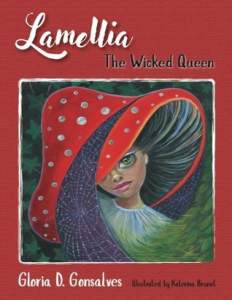
Lamellia: The Wicked Queen is a charming story by Gloria D. Gonsalves, with the talented brushstrokes of Katerina Brunot bringing color and depth into this imaginative book for children.
Lamellia, the kingdom of mushrooms, is a magical place that would be perfect were it not for the fact that its rulers, King Polipoli and Queen Nobilia, have remained childless. This has left the queen constantly singing sad songs, making those around her sad as well.
One day, one of the king’s Lantern guards finds a human baby while walking in the forest. The baby is brought back to the kingdom where King Polipoli, desperate to make his wife happy again, decides to adopt the baby girl, naming her Tiara. Ironically, everyone in the kingdom dotes on little Tiara, except for the queen, who keeps her distance.
When Tiara finally gets close enough to touch her one day, Queen Nobilia’s eyes turn green, making Tiara convulse until she loses consciousness. The Lantern guard on duty investigates, but the queen also renders him unconscious and then later accuses him of trying to poison Tiara when he regains consciousness. The king orders the guard put to death and this cycle continues several more times, until Tiara becomes sick, no longer able to crawl or eat. A desperate King Polipoli sends his Lantern guards to the Forest of Eucalyptia for healing medicines to save his child, little realizing that the forest tree roots have more to share than just healing powers…
Like most fables, the lines between good and evil are clearly drawn in Lamellia, but Gonsalves takes it a step further by introducing concepts of kindness, tolerance, and the ability to love despite obvious differences. And while anthropomorphism certainly isn’t a new concept in children’s books, human attributes are typically given to animals in order to educate children on proper behavior and acceptable values. By applying human attributes to mushrooms and other woodland life, Gonsalves takes a more unique approach, teaching younger readers about nature in general, as well as healing through the use of natural remedies.
Though darkness is inherent in a great many children’s stories, this book may cross the line in several places, especially in the use of the word “execute” in the narrative – a word that is far too harsh for a children’s story. Gonsalves would have been better served alluding to the Lantern guard’s fate rather than bluntly stating it. The baby’s fate can be overly harrowing as well, especially considering that the baby has been lost from her real parents, as described in the first Lamellia book.
The accompanying illustrations complement the story beautifully, although there could have been a few more to support the length of the narrative, which is quite long for a book aimed at this age range. Brunot’s illustrations are complex and rich in color, serving to educate the reader and tell the story in an engaging manner, with each painted illustration seeming like a work of art all its own.
Overall, Lamellia: The Wicked Queen works well as a first reader or as a longer bedtime story. Engrossing and educational, it’s sure to encourage young readers to explore the natural world around them.
Book Links
STAR RATING
Design
Content
Editing
Get an Editorial Review | Get Amazon Sales & Reviews | Get Edited | Get Beta Readers | Enter the SPR Book Awards | Other Marketing Services























Leave A Comment